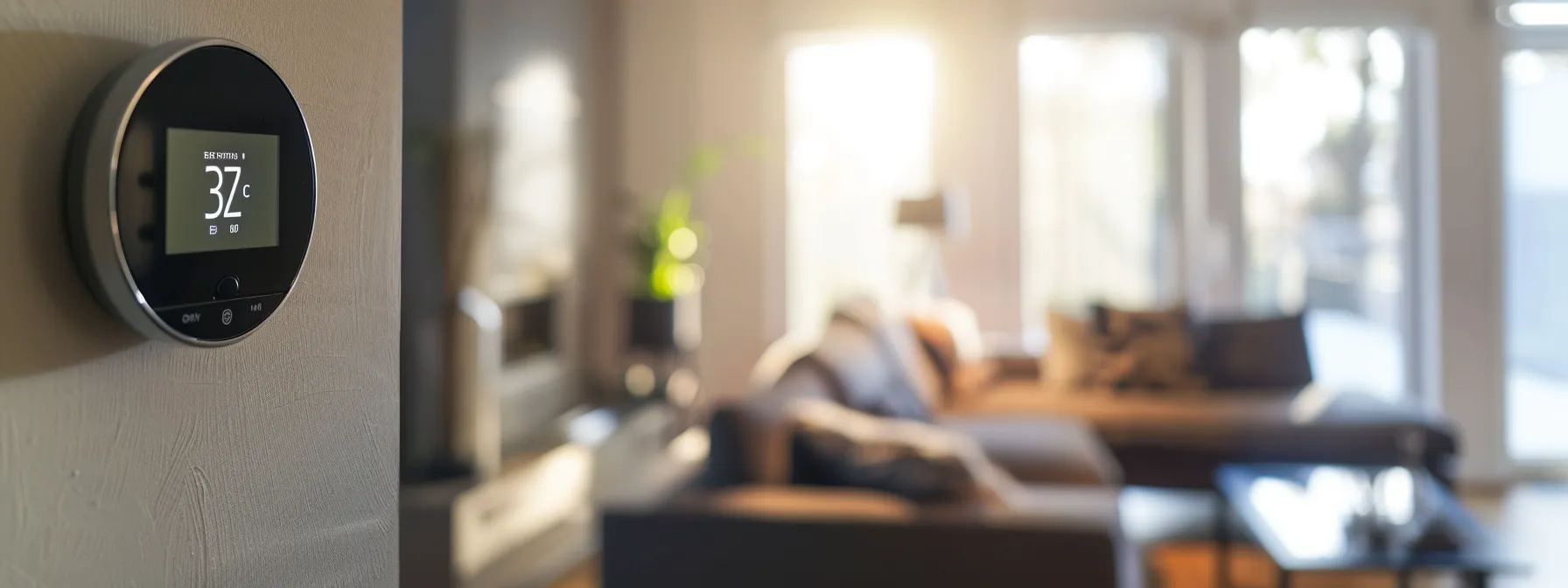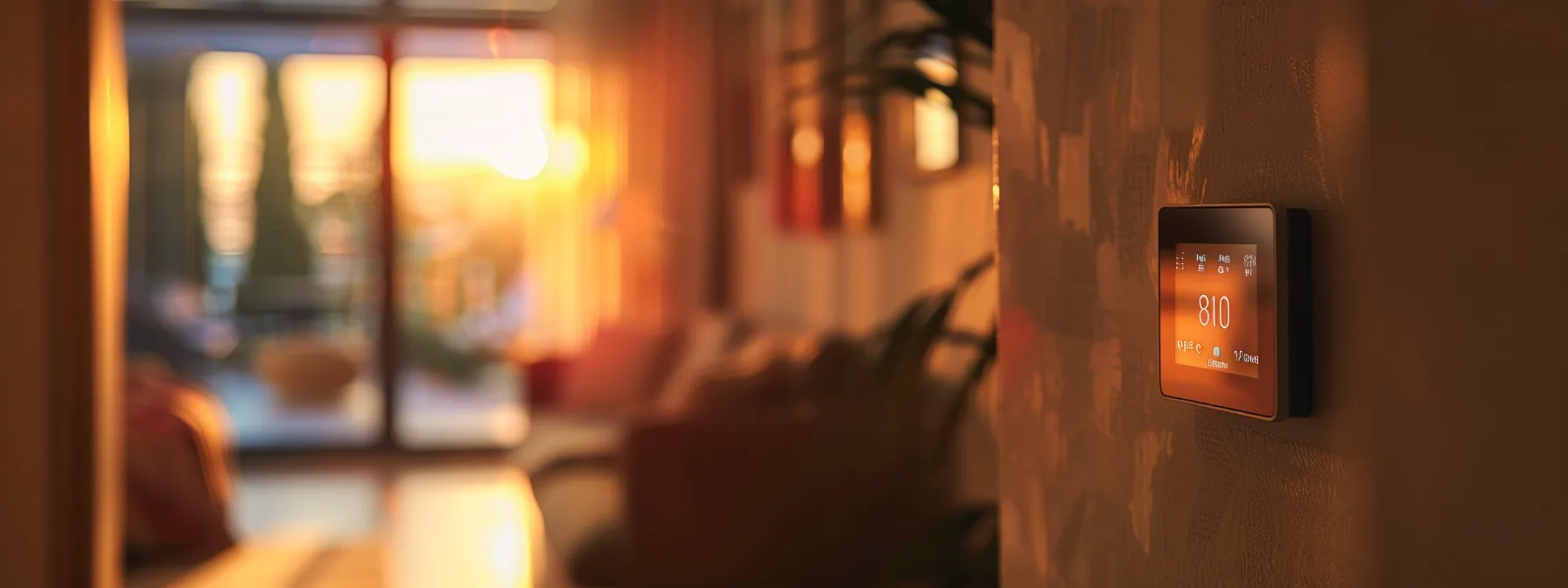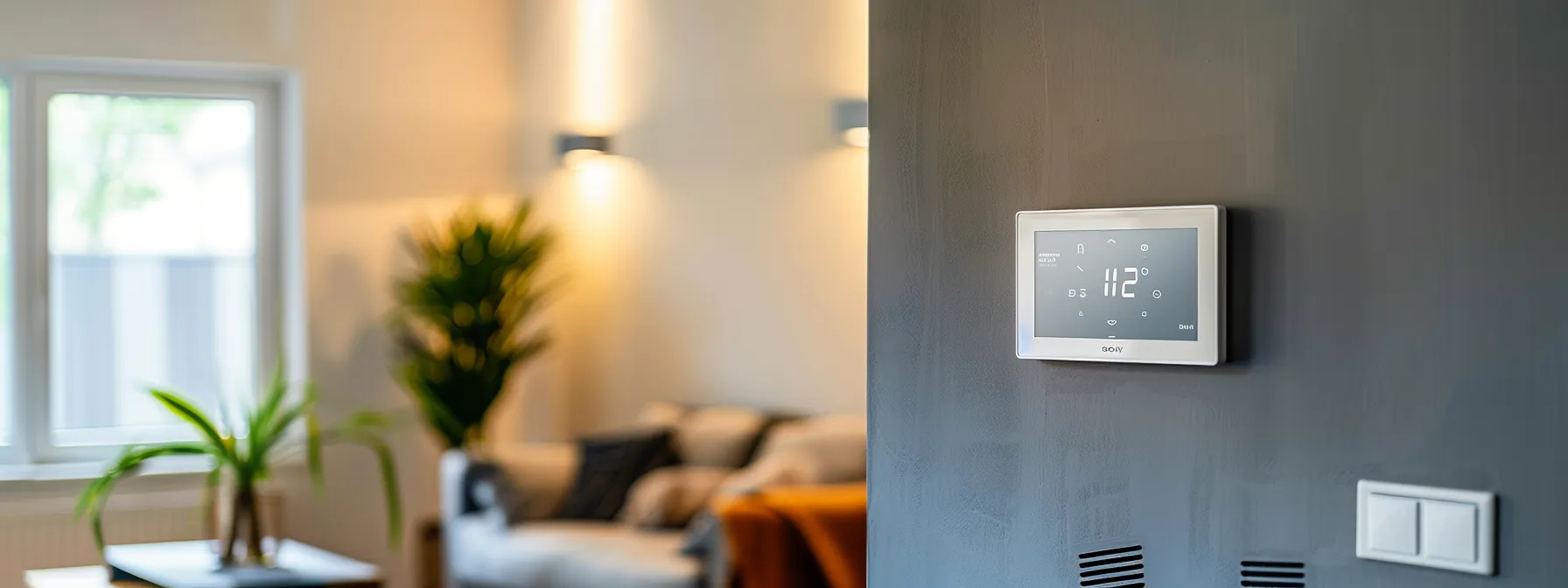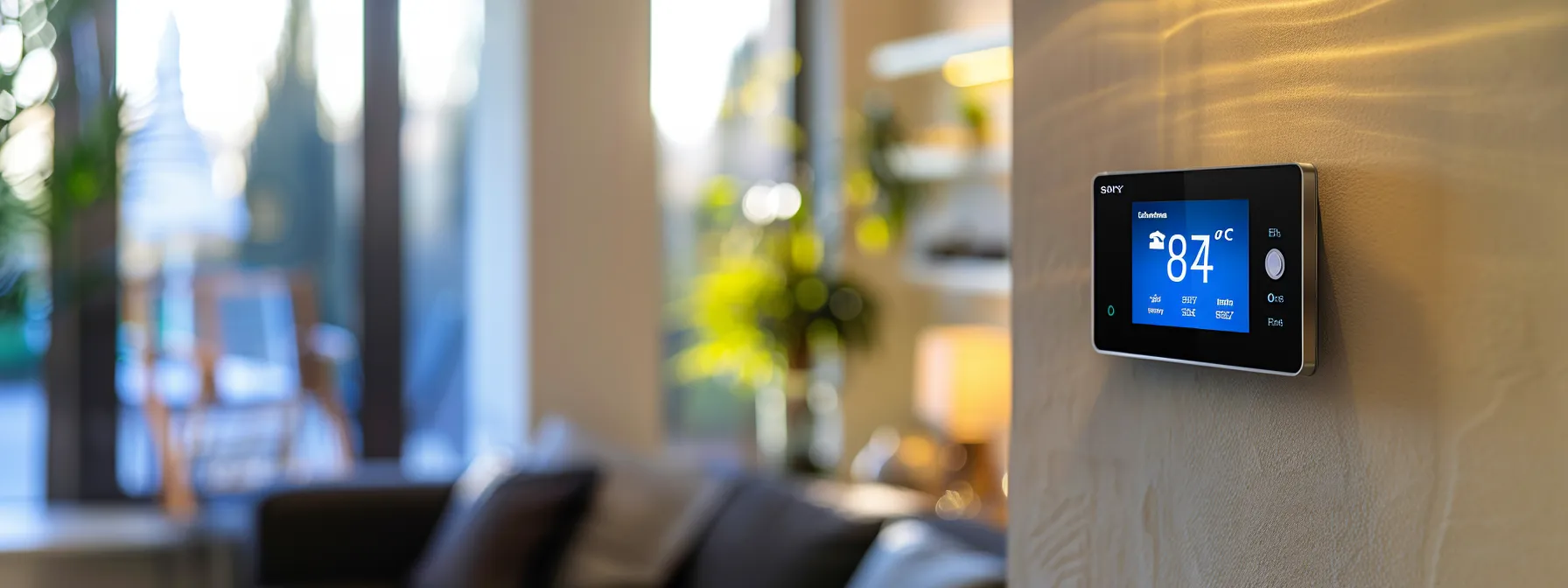
Common Problems With Thermostats and How to Fix Them
Is your thermostat acting up, leaving you uncomfortable and frustrated? Thermostats are crucial for maintaining a comfortable home environment, but they can develop issues over time. This article will explore common thermostat problems, provide troubleshooting steps, and offer guidance on when to replace your device. We’ll also share maintenance tips to extend your thermostat’s lifespan. By understanding these aspects, you’ll be better equipped to manage your home’s temperature control system effectively.
Essential Key Takeaways for Thermostat Troubleshooting and Maintenance
- Regular thermostat maintenance is crucial for optimal HVAC performance and energy efficiency
- Smart thermostats offer advanced features for better temperature control and energy management
- Professional installation ensures proper integration and optimal settings for complex thermostat systems
- Seasonal tune-ups help identify potential issues and maintain thermostat accuracy
- Local AC repair specialists can quickly diagnose and fix thermostat-related problems
Identifying Common Issues With Thermostats

Thermostat issues can disrupt home comfort and efficiency. This section explores common problems, including recognizing symptoms, understanding different types of malfunctions, evaluating power supply issues, investigating wiring connections, and examining settings errors. Homeowners can use these insights to troubleshoot their heating systems, potentially avoiding costly repairs. Modern thermostats, including those with camera features or HomeKit compatibility, may require specific diagnostics.
Recognizing Symptoms of a Malfunctioning Thermostat
Homeowners may notice their electric heating systems behaving erratically, which could indicate a malfunctioning thermostat. Inconsistent room temperatures, frequent cycling of the HVAC system, or a complete failure to turn on are common symptoms that warrant investigation.
Different thermostat brands may exhibit unique issues, but general signs include unresponsive displays or incorrect temperature readings. These problems can impact not only comfort but also energy efficiency and potentially the health of occupants if indoor temperatures become extreme.
Checking the thermostat’s voltage and ensuring proper electrical connections is crucial for diagnosing issues. In some cases, simply cleaning the device or applying a suitable lubricant to moving parts can resolve minor problems, but persistent symptoms often require professional assessment.
Understanding Different Types of Thermostat Problems
Thermostats can experience various issues, from freezing displays to inconsistent air conditioning control. Some common problems include faulty wiring, sensor malfunctions, and calibration errors. Homeowners may notice their HVAC systems cycling too frequently or failing to maintain desired temperatures.
Power-related issues often cause thermostat failures. Dead batteries, tripped circuit breakers, or loose connections can render a thermostat inoperative. In some cases, a technician may need to inspect the unit’s internal components or check the HVAC system’s compatibility with the thermostat.
Smart thermostats can encounter unique problems related to their advanced features. Wi-Fi connectivity issues, software glitches, or incompatibility with home automation systems like HomeKit can disrupt operation. Homeowners should check for firmware updates and ensure proper network settings to resolve these issues. Common thermostat problems include:
- Incorrect temperature readings
- Unresponsive controls or blank displays
- Short cycling of HVAC equipment
- Failure to switch between heating and cooling modes
- Connectivity issues for smart thermostats
Evaluating Battery and Power Supply Issues
Battery-powered thermostats require regular maintenance to ensure optimal performance. Homeowners should check and replace batteries as needed, especially in Honeywell smart thermostats, which may display low battery warnings on their menu screens. Weak batteries can cause erratic behavior, including unexpected noise or failure to maintain set temperatures.
For hardwired thermostats, power supply issues often stem from tripped circuit breakers or blown fuses. Homeowners should inspect their electrical panel and reset breakers if necessary. Some smart thermostats with Bluetooth connectivity may experience power-related problems that affect their wireless functions.
Proper voltage is crucial for thermostat operation. Technicians use multimeters to measure voltage at the thermostat and in the HVAC system, including the flue area. Incorrect voltage can lead to thermostat malfunction and potentially damage the HVAC system. Common power-related issues include:
- Dead or weak batteries in battery-operated units
- Tripped circuit breakers or blown fuses
- Loose wiring connections
- Voltage fluctuations affecting smart thermostat functions
- Power surges damaging internal components
Investigating Wiring and Connections
Proper wiring connections are crucial for thermostat functionality. Homeowners should inspect visible wires for signs of damage or loose connections, which can lead to erratic behavior in smart devices. A thorough inspection may reveal issues with wire insulation or corroded terminals that require professional attention.
Technicians often use specialized tools to test wiring integrity and ensure correct voltage levels. During this process, they may check related components such as gaskets and hoses for signs of wear or damage that could affect system performance. Proper diagnosis requires a comprehensive understanding of HVAC systems and their interaction with modern thermostats.
As thermostats become more advanced, incorporating artificial intelligence and complex circuitry, wiring problems can manifest in unexpected ways. Homeowners experiencing persistent issues should consult with HVAC professionals who can perform detailed diagnostics and make necessary repairs or upgrades to ensure optimal air conditioning performance.
Examining Settings and Programming Errors
Incorrect thermostat settings can lead to significant comfort and efficiency issues in homes. Homeowners may inadvertently set improper temperature setpoints or incorrectly program their devices, resulting in unexpected HVAC behavior. Verifying these settings, especially when replacing an old thermostat with a digital model, can often resolve apparent malfunctions.
Programming errors commonly occur when users input incorrect schedules or fail to account for changes in occupancy patterns. Smart thermostats may require recalibration of their learning algorithms if household routines shift. Adjusting humidity settings can also impact overall system performance, particularly in regions where moisture control is crucial.
Advanced features like antifreeze protection or energy-saving modes may confuse some users, leading to unintended operation. Homeowners should review their thermostat’s manual to understand these functions fully. Some digital thermostats offer tax incentives for energy-efficient operation, making proper programming not only a comfort issue but also a financial consideration.
Troubleshooting Steps for Thermostat Repair

Effective thermostat troubleshooting involves systematic steps to identify and resolve issues. This section covers restarting or resetting thermostats, cleaning procedures, battery replacement, wiring checks, and setting adjustments. These techniques apply to various models, including the Daikin One+ smart thermostat, and consider factors like weather and smart speaker integration. Proper maintenance ensures optimal performance in heating and cooling systems, impacting both comfort and energy efficiency in construction and home environments.
Steps to Restart or Reset Your Thermostat
Restarting a thermostat often resolves minor issues and can be accomplished by turning off the device’s power supply for a few minutes before restoring it. For wireless thermostats, this may involve removing and reinserting batteries or unplugging and reconnecting the unit. Some smart thermostats compatible with Google Assistant may require a specific reset sequence outlined in their user manuals.
Resetting a thermostat to factory defaults can address more persistent problems but may erase custom settings and schedules. Homeowners should consult their device’s policy regarding data retention before performing a full reset. Many modern thermostats offer cloud backup features, allowing users to restore their preferences after a reset through their Amazon or manufacturer accounts.
After resetting, users should reconfigure their thermostats, including wi-fi connections, payment information for energy-saving programs, and integration with smart home systems. It’s crucial to verify that the thermostat reconnects properly to the HVAC system and maintains accurate temperature control. If issues persist following a reset, professional diagnosis may be necessary to identify potential hardware failures or compatibility problems with the air conditioning.
Cleaning and Maintenance Procedures for Optimal Performance
Regular cleaning of thermostats helps maintain optimal HVAC performance and can prevent costly repairs. Homeowners should gently remove dust and debris from thermostat surfaces and internal components using a soft brush or compressed air. For digital thermostats like Google Nest, cleaning the display and ensuring proper ventilation can improve accuracy and responsiveness.
Maintenance procedures include checking and tightening wire connections, which can loosen over time due to temperature fluctuations and vibrations. Homeowners should also inspect the thermostat’s level, as an uneven installation can affect its ability to accurately measure room temperature. Proper maintenance can help mitigate the impact of inflation on energy costs by ensuring efficient HVAC operation.
For systems with integrated humidifiers, regular cleaning of water panels and checking drain lines is essential to prevent mold growth and maintain indoor air quality. Homeowners should consult their thermostat’s manual for specific maintenance instructions, as procedures may vary between models. Proper care of thermostats and associated HVAC components can extend system lifespan and improve overall performance:
| Maintenance Task | Frequency | Benefit |
|---|---|---|
| Clean thermostat exterior | Monthly | Improved accuracy |
| Check wire connections | Annually | Prevent malfunctions |
| Clean humidifier components | Seasonally | Better air quality |
| Verify thermostat level | Bi-annually | Accurate temperature control |
Techniques for Replacing Batteries in Your Thermostat
Replacing batteries in thermostats requires careful attention to detail, especially for advanced models like the Lennox iComfort thermostat 10F81. Homeowners should consult their device’s manual for specific instructions, as battery compartment locations and types can vary. Some thermostats use standard AA or AAA batteries, while others may require specialized coin cell batteries.
For touchscreen thermostats, users must exercise caution to avoid damaging the display when accessing the battery compartment. Gentle pressure and the correct tool, often a small flathead screwdriver, can help remove the faceplate without causing harm. Homeowners should clean any wax buildup or debris from battery contacts using a soft, dry cloth to ensure proper connection.
After replacing batteries, users should verify that the thermostat’s technology functions correctly, including Wi-Fi connectivity and integration with smart home platforms like Facebook. Some thermostats may require recalibration or reconnection to home networks following a battery change. Proper battery maintenance ensures consistent performance and prevents unexpected system shutdowns during critical heating or cooling periods.
Checking and Replacing Faulty Wiring Connections
Homeowners should inspect thermostat wiring connections regularly, especially when troubleshooting issues with ecobee3 thermostats or Google thermostats. Loose or corroded wires can cause erratic behavior, including problems with flame sensors in heating systems. Technicians often use specialized tools from their trucks to test and repair faulty connections.
When checking wiring, it’s crucial to turn off power to the HVAC system at the circuit breaker. Homeowners can gently tug on each wire to ensure secure connections and look for signs of wear or damage. If issues persist with an ecobee WiFi thermostat, users should verify proper installation of the Power Extender Kit (PEK) for consistent operation and air conditioning.
Replacing faulty wiring requires careful attention to color coding and terminal labels. Homeowners should document the original wiring configuration before making changes. For complex systems or when uncertainty arises, it’s advisable to consult a professional HVAC technician to ensure proper installation and avoid potential damage to the thermostat or HVAC components:
| Wire Color | Function | Common Issues |
|---|---|---|
| Red | Power (24V) | Loose connection, voltage drop |
| White | Heat | Corrosion, intermittent heating |
| Green | Fan | Fan runs constantly or not at all |
| Yellow | Cooling | AC fails to start, short cycling |
Adjusting Thermostat Settings for Improved Accuracy
Accurate thermostat settings are crucial for optimal HVAC performance and energy efficiency. Homeowners can improve accuracy by calibrating their thermostats, especially older bimetal models, which may drift over time. For digital thermostats like Honeywell units, calibration often involves accessing a menu option and adjusting the displayed temperature to match a reliable thermometer reading.
Proper thermostat placement significantly impacts accuracy. Devices should be installed away from direct sunlight, drafts, and heat sources like electronics or lighting fixtures. Some smart thermostats use remote sensors to gather temperature data from multiple rooms, providing a more comprehensive view of home comfort needs and improving overall system efficiency.
Advanced features in modern thermostats, such as learning algorithms and encryption for data security, can enhance accuracy when properly configured. Homeowners should familiarize themselves with these settings and adjust them according to their lifestyle and preferences. Regular updates to smart thermostat software can also improve accuracy and introduce new energy-saving features.
When to Consider Thermostat Replacement

Recognizing when to replace a thermostat is crucial for maintaining efficient HVAC systems. This section explores signs indicating the need for a new thermostat, compares traditional and smart models, highlights benefits of upgrading to an Ecobee programmable thermostat, discusses professional versus DIY installation, and examines cost considerations. Understanding these factors helps homeowners in the United States make informed decisions about thermostat replacement, potentially improving temperature control and reducing energy costs.
Signs It’s Time for a New Thermostat
Homeowners should consider replacing their thermostats when they notice consistent temperature inconsistencies throughout their living spaces. This issue may persist even after adjusting settings or performing basic maintenance, indicating a potential failure in the thermostat’s ability to communicate effectively with the HVAC system. In some cases, these inconsistencies can lead to unnecessary strain on plumbing systems, particularly in areas prone to freezing.
Frequent HVAC system cycling or short-cycling can signify a thermostat nearing the end of its lifespan. This behavior not only increases energy consumption but can also cause premature wear on HVAC components, potentially leading to costly repairs. Homeowners with older models may benefit from upgrading to an ecobee wireless thermostat, which offers advanced features for improved energy management and comfort control.
Physical damage or visible wear on the thermostat, such as a cracked display or unresponsive buttons, often necessitates replacement. These issues can arise from various factors, including accidental impacts during home maintenance activities like drywall repairs or general deterioration over time. When considering a replacement, homeowners should evaluate their needs, including compatibility with existing systems and potential integration with other smart home devices.
Comparing Traditional and Smart Thermostats
Traditional thermostats rely on basic temperature sensing mechanisms, while smart thermostats incorporate advanced features like Wi-Fi connectivity and learning algorithms. In Northwest Indiana, where pressure changes can affect HVAC performance, smart thermostats offer more precise control over temperature and humidity levels. These devices can also integrate with home networks, allowing users to monitor and adjust settings remotely via their internet address.
Smart thermostats excel in energy management, potentially reducing utility costs through intelligent scheduling and occupancy detection. For homeowners seeking same-day AC repair, smart thermostats can provide diagnostic information to technicians, streamlining the repair process. Additionally, these devices often offer detailed energy usage reports, helping users optimize their HVAC system’s efficiency.
While traditional thermostats may suffice for basic temperature control, smart thermostats provide valuable features for inventory management of HVAC components. They can alert homeowners to maintenance needs, track filter life, and even integrate with smart home systems for comprehensive energy management. This proactive approach can extend equipment lifespan and improve overall system performance in varying climate conditions.
Benefits of Upgrading to an Ecobee Thermostat
Upgrading to an Ecobee thermostat offers homeowners advanced temperature control and energy management capabilities. These devices integrate seamlessly with existing HVAC equipment, including ventilation systems, to optimize comfort and efficiency. Ecobee thermostats also provide 24/7 AC repair diagnostics, alerting users to potential issues before they escalate into major problems.
Ecobee’s smart sensors allow for more accurate temperature readings throughout the home, addressing common issues with traditional thermostats. This feature ensures consistent comfort in occupied rooms and can significantly reduce energy waste. Many utility companies offer rebates for installing Ecobee thermostats, making the upgrade more affordable for homeowners seeking to improve their HVAC system’s performance.
The Ecobee thermostat’s intuitive interface and mobile app make it easy for users to adjust settings and monitor energy usage. This level of control surpasses that of older models like Emerson thermostats, providing homeowners with detailed insights into their HVAC system’s operation. The ability to fine-tune schedules and set up geofencing further enhances energy savings and comfort, making Ecobee a valuable addition to any home’s climate control system.
Professional Installation vs. DIY Replacement
Professional installation of thermostats, particularly advanced models like the ecobee pro thermostat, ensures proper integration with existing HVAC systems and building insulation. Technicians possess the expertise to address complex wiring configurations and can optimize settings based on the home’s unique climate conditions. This approach minimizes the risk of installation errors that could lead to system inefficiencies or damage.
DIY replacement may be suitable for homeowners with basic electrical knowledge and simpler thermostat models. However, it requires careful consideration of factors such as compatibility with existing equipment, proper wire connections, and understanding of HVAC system operations. Incorrect installation can affect not only comfort but also the longevity of HVAC components, potentially leading to issues with liquid refrigerant or other system fluids.
The decision between professional and DIY installation often depends on the thermostat’s complexity and the homeowner’s technical skills. While DIY can save on immediate costs, professional installation offers peace of mind and may include additional services such as system checks and personalized programming. Homeowners should weigh these factors against potential long-term benefits, including improved energy efficiency and the possibility of extended warranty coverage.
Cost Considerations for Thermostat Replacement
Thermostat replacement costs vary depending on the model and installation complexity. Basic digital thermostats may cost as little as $20, while advanced WiFi-enabled models can range from $100 to $500. Homeowners should consider long-term energy savings when evaluating the initial investment, as smart thermostats can significantly reduce heating and cooling expenses through efficient management.
Installation costs can impact the overall expense of thermostat replacement. While DIY installation can save money, professional installation ensures proper setup and may be necessary for complex systems or when replacing older models. Some HVAC companies offer package deals that include thermostat replacement with furnace exchange services, potentially providing cost savings.
Homeowners can offset replacement costs through various means. Many utility companies offer rebates or coupons for upgrading to energy-efficient thermostats. Additionally, some manufacturers provide promotional discounts or bundle deals when purchasing multiple smart home devices. When considering costs, homeowners should factor in potential savings on floor heating and cooling expenses over time:
- Initial thermostat purchase price
- Installation fees (professional or DIY)
- Potential energy savings over time
- Available rebates or promotions
- Compatibility with existing HVAC systems
HVAC Maintenance Tips for Longevity

Regular HVAC maintenance is crucial for system longevity and efficient thermostat operation. This section covers essential checks, seasonal tune-ups, and the importance of professional services. Homeowners will learn about adjusting thermostats, including Honeywell models, and maintaining components like evaporators. Tips on finding reliable local AC repair specialists and utilizing resources for ongoing maintenance will help prevent wear and extend system life. Understanding these aspects ensures optimal performance of heating and cooling systems, including hydronic setups.
Regular Checks and Adjustments for Your Thermostat
Regular thermostat checks are essential for maintaining HVAC efficiency in Indiana homes. Homeowners should verify temperature accuracy by comparing readings with a reliable thermometer, ensuring their ecobee commercial thermostat or other models are calibrated correctly. This simple step can prevent unnecessary energy consumption and maintain comfort levels.
Adjusting thermostat settings seasonally can lead to significant energy savings and improve system longevity. By programming appropriate temperature setbacks during unoccupied hours, homeowners can reduce wear on their HVAC equipment and potentially lower their need for cheap AC repair services. Proper scheduling also ensures optimal comfort when residents return home.
Periodic inspection of thermostat wiring and connections is crucial for preventing malfunctions. Loose or corroded wires can cause erratic behavior in HVAC systems, potentially affecting other home systems like doorbells. Homeowners should consult their thermostat’s manual for guidance on safe inspection procedures or consider professional maintenance to ensure proper functionality and avoid unexpected repair costs.
Importance of Seasonal HVAC Tune-Ups
Seasonal HVAC tune-ups are a crucial investment in maintaining thermostat accuracy and system efficiency. These routine checks help identify potential issues before they escalate, ensuring optimal performance of programmable thermostats and preventing costly repairs. Homeowners can find valuable tutorials on YouTube for basic maintenance tasks, but professional inspections offer comprehensive evaluations of complex system components.
Regular tune-ups contribute to the longevity of HVAC systems and their integration with home automation platforms. Technicians can verify that smart thermostats, including those compatible with Apple Watch, are communicating effectively with heating and cooling units. This synergy between devices maximizes energy efficiency and enhances user comfort through precise temperature control.
Professional HVAC maintenance aligns system performance with changing seasonal demands. Technicians adjust thermostat settings, clean critical components, and calibrate sensors to ensure accurate temperature readings. These services often include a thorough inspection of the entire HVAC system, addressing potential issues that could impact thermostat function:
| Tune-up Task | Benefit | Frequency |
|---|---|---|
| Thermostat calibration | Improved accuracy | Biannually |
| Filter replacement | Enhanced air quality | Quarterly |
| Ductwork inspection | Efficient air distribution | Annually |
| System software updates | Optimized performance | As needed |
Finding Reliable Air Conditioner Repair Services Nearby
When seeking reliable air conditioner repair services, homeowners should prioritize technicians who can quickly diagnose and address thermostat issues affecting central heating systems. Reputable companies often offer emergency services to handle urgent problems, such as faulty switches or potential carbon monoxide leaks. Homeowners can research local HVAC professionals online, focusing on those with positive reviews and experience with various refrigerant models.
Selecting a service provider that offers flexible payment options, including credit plans, can make unexpected repairs more manageable for homeowners. Many reputable HVAC companies provide detailed estimates and transparent pricing, allowing customers to make informed decisions about their air conditioning repairs. It’s advisable to choose technicians who are certified to work on specific brands and can ensure the proper functioning of safety features like carbon monoxide detectors.
Homeowners should look for HVAC services that offer comprehensive maintenance plans, which often include regular thermostat checks and system tune-ups. These plans can help prevent issues with thermostat speed and accuracy, ultimately extending the lifespan of the entire HVAC system. Reliable technicians will educate homeowners on proper thermostat usage and provide tips for optimizing central heating efficiency, potentially reducing long-term repair costs.
Utilizing Local AC Repair Specialists for Quick Fixes
Local AC repair specialists can provide quick fixes for thermostat issues, often addressing problems with ecobee smart thermostats or sensi thermostats efficiently. These experts understand the intricacies of various thermostat models and can quickly diagnose issues related to wiring, sensor malfunctions, or geofence settings. Their expertise ensures that homeowners can restore proper HVAC functionality without prolonged discomfort.
When pipes or other HVAC components affect thermostat performance, local AC repair technicians have the tools and knowledge to address these interconnected issues promptly. They can assess whether thermostat problems stem from the device itself or are symptoms of larger system malfunctions. This comprehensive approach helps prevent recurring issues and ensures long-term HVAC efficiency.
Utilizing local AC repair services for quick fixes can be cost-effective and time-saving for homeowners experiencing thermostat difficulties. These specialists often offer emergency services and can provide temporary solutions to maintain comfort while ordering necessary parts or planning more extensive repairs. Their proximity allows for rapid response times, which is crucial when dealing with climate control issues in extreme weather conditions:
| Service | Benefit | Typical Response Time |
|---|---|---|
| Emergency Thermostat Repair | Immediate Comfort Restoration | 1-4 Hours |
| Diagnostic Assessment | Accurate Problem Identification | Same Day |
| Temporary Fix Implementation | Minimized Downtime | During Initial Visit |
| Permanent Solution Planning | Long-term Reliability | Within 1-2 Business Days |
Recommended Resources for Ongoing HVAC Maintenance
Homeowners can access comprehensive HVAC maintenance guides through manufacturers’ websites, which often provide detailed information on thermostat care and system optimization. These resources typically include step-by-step instructions for tasks like cleaning glass touchscreens on smart thermostats and adjusting settings to accommodate climate change impacts. Many guides also offer troubleshooting tips for common issues, helping users maintain their systems efficiently.
Online forums and community groups dedicated to home automation and HVAC maintenance can be valuable resources for ongoing system care. These platforms allow homeowners to share experiences, ask questions, and learn from others who have dealt with similar thermostat and HVAC issues. Users can often find specific advice on integrating thermostats with honeywell hubs or other home automation systems, enhancing overall energy efficiency.
Professional HVAC associations and environmental agencies offer educational materials on proper system maintenance, including information on refrigerant handling and energy-saving practices. These resources often provide insights into the latest technologies and best practices for maintaining HVAC systems in changing environmental conditions. Homeowners can use this information to make informed decisions about system upgrades and maintenance schedules, ensuring optimal performance and longevity of their HVAC equipment.
Frequently Asked Questions
How can I tell if my thermostat is malfunctioning?
A malfunctioning thermostat often exhibits inconsistent temperature readings, frequent on/off cycling of your HVAC system, or failure to respond to setting changes. You may notice your home feeling too warm or too cold despite adjusting the thermostat, or your energy bills might unexpectedly increase due to inefficient operation. To further investigate, check if the thermostat’s display is functioning correctly and if it’s level on the wall. Replace the batteries if applicable. If problems persist, consider contacting a professional HVAC technician to diagnose and resolve any underlying issues with your thermostat or heating and cooling system.
What are some simple troubleshooting steps for a faulty thermostat?
Check the thermostat’s power source first. Replace batteries if needed or ensure it’s properly connected to the electrical system. Verify the temperature settings and make sure the thermostat is set to the correct mode (heating or cooling). Clean any dust or debris that may be affecting its operation. If these steps don’t resolve the issue, check for loose wiring connections. Gently remove the thermostat cover and inspect the wires. Tighten any loose connections and ensure all wires are securely attached. If problems persist, consider calling a professional HVAC technician for further diagnosis and repair. Indoor air quality
When should I replace my thermostat instead of repairing it?
Consider replacing your thermostat if it’s over 10 years old, consistently inaccurate, or incompatible with your HVAC system. Frequent malfunctions, difficulty programming, or a lack of energy-saving features are also signs that replacement may be more cost-effective than repair. If your home’s energy bills have increased unexpectedly or your HVAC system cycles on and off too frequently, a new thermostat could solve these issues. Smart thermostats offer improved efficiency and convenience, making them a worthwhile upgrade for many homeowners seeking better home automation.
What regular maintenance can I perform on my HVAC system?
Regular HVAC maintenance includes changing air filters every 1-3 months, keeping outdoor units clear of debris, and cleaning vents and registers. Homeowners can also inspect ductwork for leaks, clean condensate drains, and ensure thermostat batteries are fresh. These simple tasks help maintain system efficiency and indoor air quality. Professional maintenance is recommended annually for thorough inspections and servicing. HVAC technicians can check refrigerant levels, clean coils, lubricate moving parts, and calibrate thermostats. Regular upkeep extends system lifespan, improves energy efficiency, and prevents costly breakdowns, ensuring comfortable air conditioning year-round.
How do thermostat issues affect overall HVAC performance?
Thermostat issues can significantly impact HVAC performance. Inaccurate temperature readings or faulty wiring may cause the system to cycle on and off too frequently, leading to increased energy consumption and uneven heating or cooling throughout the home. This can result in discomfort and higher utility bills. A malfunctioning thermostat may also fail to communicate properly with the HVAC system, preventing it from activating when needed or running unnecessarily. This can strain system components, reduce efficiency, and potentially shorten the lifespan of the equipment. Regular thermostat maintenance and calibration are essential for optimal HVAC performance.
Conclusion
Identifying and addressing common thermostat problems is crucial for maintaining optimal HVAC performance, energy efficiency, and home comfort. Regular maintenance, including cleaning, battery replacement, and wiring checks, can prevent many issues and extend the lifespan of both thermostats and HVAC systems. Homeowners should be vigilant for signs of thermostat malfunction, such as inconsistent temperatures or frequent system cycling, and consider upgrading to smart thermostats for improved control and energy savings. Ultimately, whether opting for DIY solutions or professional services, addressing thermostat issues promptly can lead to significant cost savings, improved indoor air quality, and enhanced overall home comfort.